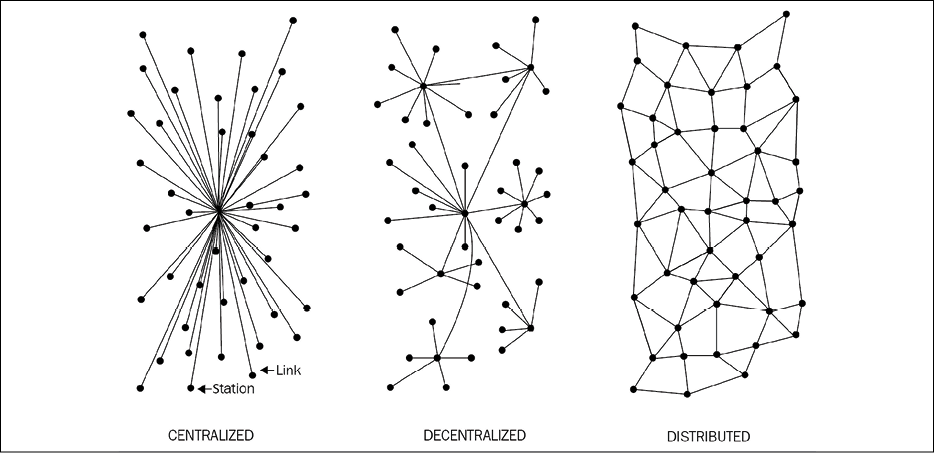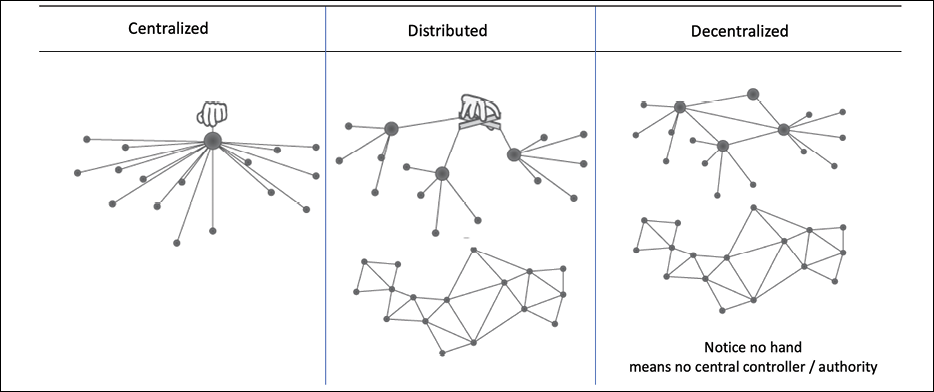Decentralization using blockchain
Decentralization is a core benefit and service provided by blockchain technology. By design, blockchain is a perfect vehicle for providing a platform that does not need any intermediaries and that can function with many different leaders chosen via consensus mechanisms. This model allows anyone to compete to become the decision-making authority. A consensus mechanism governs this competition, and the most famous method is known as Proof of Work (PoW).
Decentralization is applied in varying degrees from a semi-decentralized model to a fully decentralized one depending on the requirements and circumstances. Decentralization can be viewed from a blockchain perspective as a mechanism that provides a way to remodel existing applications and paradigms, or to build new applications, to give full control to users.
Information and communication technology (ICT) has conventionally been based on a centralized paradigm whereby database or application servers are under the control of a central authority, such as a system administrator. With Bitcoin and the advent of blockchain technology, this model has changed, and now the technology exists to allow anyone to start a decentralized system and operate it with no single point of failure or single trusted authority. It can either be run autonomously or by requiring some human intervention, depending on the type and model of governance used in the decentralized application running on the blockchain.
The following diagram shows the different types of systems that currently exist: central, distributed, and decentralized. This concept was first published by Paul Baran in On Distributed Communications: I. Introduction to Distributed Communications Networks (Rand Corporation, 1964):

Figure 2.1: Different types of networks/systems
Centralized systems are conventional (client-server) IT systems in which there is a single authority that controls the system, and who is solely in charge of all operations on the system. All users of a centralized system are dependent on a single source of service. The majority of online service providers, including Google, Amazon, eBay, and Apple's App Store, use this conventional model to deliver services.
In a distributed system, data and computation are spread across multiple nodes in the network. Sometimes, this term is confused with parallel computing. While there is some overlap in the definition, the main difference between these systems is that in a parallel computing system, computation is performed by all nodes simultaneously in order to achieve the result; for example, parallel computing platforms are used in weather research and forecasting, simulation, and financial modeling. On the other hand, in a distributed system, computation may not happen in parallel and data is replicated across multiple nodes that users view as a single, coherent system. Variations of both of these models are used to achieve fault tolerance and speed. In the parallel system model, there is still a central authority that has control over all nodes and governs processing. This means that the system is still centralized in nature.
The critical difference between a decentralized system and distributed system is that in a distributed system, there is still a central authority that governs the entire system, whereas in a decentralized system, no such authority exists.
A decentralized system is a type of network where nodes are not dependent on a single master node; instead, control is distributed among many nodes. This is analogous to a model where each department in an organization is in charge of its own database server, thus taking away the power from the central server and distributing it to the sub-departments, who manage their own databases.
A significant innovation in the decentralized paradigm that has given rise to this new era of decentralization of applications is decentralized consensus. This mechanism came into play with Bitcoin, and it enables a user to agree on something via a consensus algorithm without the need for a central, trusted third party, intermediary, or service provider.
We can also now view the different types of networks shown earlier from a different perspective, where we highlight the controlling authority of these networks as a symbolic hand, as shown in the following diagram. This model provides a clearer understanding of the differences between these networks from a decentralization point of view:

Figure 2.2: Different types of networks/systems depicting decentralization from a modern perspective
The preceding diagram shows that the centralized model is the traditional one in which a central controller exists, and it can be viewed as a depiction of the usual client/server model. In the middle we have distributed systems, where we still have a central controller but the system comprises many dispersed nodes. On the right-hand side, notice that there is no hand/controller controlling the networks.
This is the key difference between decentralized and distributed networks. A decentralized system may look like a distributed system from a topological point of view, but it doesn't have a central authority that controls the network.
The differences between distributed and decentralized systems can also be viewed at a practical level in the following diagrams:

Figure 2.3: A traditional distributed system comprises many servers performing different roles
The following diagram shows a decentralized system (based on blockchain) where an exact replica of the applications and data is maintained across the entire network on each participating node:

Figure 2.4: A blockchain-based decentralized system (notice the direct P2P connections and the exact replicas of blocks)
A comparison between centralized and decentralized systems (networks/applications) is shown in the following table:
|
Feature |
Centralized |
Decentralized |
|
Ownership |
Service provider |
All users |
|
Architecture |
Client/server |
Distributed, different topologies |
|
Security |
Basic |
More secure |
|
High availability |
No |
Yes |
|
Fault tolerance |
Basic, single point of failure |
Highly tolerant, as service is replicated |
|
Collusion resistance |
Basic, because it's under the control of a group or even single individual |
Highly resistant, as consensus algorithms ensure defense against adversaries |
|
Application architecture |
Single application |
Application replicated across all nodes on the network |
|
Trust |
Consumers have to trust the service provider |
No mutual trust required |
|
Cost for consumer |
Higher |
Lower |
The comparison in the table only covers some main features and is not an exhaustive list of all features. There may be other features of interest that can be compared too, but this list should provide a good level of comparison.
Now we will discuss what methods can be used to achieve decentralization.



